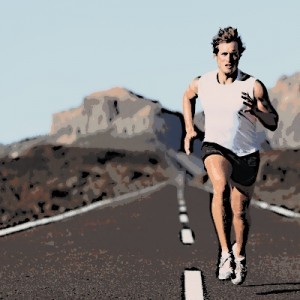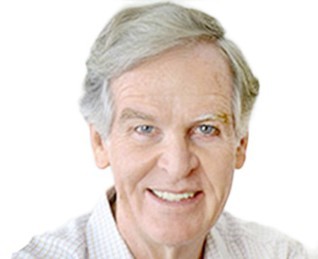How to Run with Grace and Ease (and realign your pelvis)

We are designed to run.
We ran or stumbled forward some 4.0 million years ago, long before we walked with any confidence. Walking requires more balance than running; the forward momentum of running actually aids balance.
[caption id="attachment_20158" align="alignright" width="335"] We also ran to get 'away' from our food. [photo credit: RobbWolf.com
][/caption]Bi-pedal Homo sapiens, modern man, had to run to track and hunt down his food. We weren't big enough to survive hand-to-hand combat with a bear, as the Neanderthals could, so we became persistence hunters, running that bear to exhaustion. With the development about 2.6 million years ago of the nuchal ligament
, the base support for our neck, we then had the balance and sense of space to be able to throw a spear well.
We also ran to get 'away' from our food. [photo credit: RobbWolf.com
][/caption]Bi-pedal Homo sapiens, modern man, had to run to track and hunt down his food. We weren't big enough to survive hand-to-hand combat with a bear, as the Neanderthals could, so we became persistence hunters, running that bear to exhaustion. With the development about 2.6 million years ago of the nuchal ligament
, the base support for our neck, we then had the balance and sense of space to be able to throw a spear well.
This furthered the growth of a sophisticated inner ear apparatus that gave us superior balance, allowed us to throw a spear, and to find our way back to camp. Our lighter frame required fewer calories to survive, and combined with our greater breathing capacity, our running body developed abundant and efficient sweat glands, strong and elastic Achilles tendons to reduce the need for heavy calf muscles, flexible knee joints to extend the leg, and big butt muscles to provide the power. The combination of greater spatial awareness and our slighter frame gave us significant evolutionary advantages.
Evolution has favored efficiency, both in terms of survival and of dominance. One of the hidden hallmarks of efficient walking and running is the absence of active muscular contraction. (Fukunaga et al 2002, Journal of Physiology ) Less energy and fuel are needed if the muscle fibers are held in isometric contractions, rather than going through the two-step of eccentric and concentric contraction. Every action would be stop and go if each muscle had to go from a concentric position to an eccentric position and back again without the contractile tissue aiding its progress. The fascia smoothly handles that transition without missing a beat. It works in the background, but it is vital to our efficient movement.
[caption id="attachment_20162" align="alignleft" width="300"] We're all literally born to run![/caption]
We're all literally born to run![/caption]
When the joints of the body are out of alignment, as they are for most runners, amateur or professional, young or old, male or female, muscles have to contract and extend much more than if the joints were lined up. Why? Joints and muscles working from a different anatomical place affect the contractile tissue. That misalignment, be it an anterior pelvic tilt, a forward head, thoracic ribs thrust forward, or externally rotated knees, causes contractile tissue to be less able to provide normal elasticity and continuity. Running then becomes work, and as muscles follow habituated patterns, it becomes harder to run everyday. Aging then becomes the excuse, but it's our misalignment taking the fun out of running.
Once, we had to run or hike miles each day to bring home dinner, and squatting was the standard form of rest. Today, we sit while driving a mile or walk a few blocks to the supermarket and pick up dinner.
Sitting is an eight to twelve-hour a day position. Movement is exchanged for comfort, so the muscles are shortened and the contractile fibers wrapping and connecting the muscles, tendons, and bones are shortened, too .
What can we do to put them back?
This has everything to do with running for fun, fitness, or serious competition. In life and in running, the body runs best when the working elements of the musculoskeletal system are in sync. Alignment is the way our bodies work. Posture is the way our bodies look.
Getting ourselves back in alignment takes the same dedication to our health as we have given to our running and our fitness. When you and I began running, we walked a lot, and then we jogged, and finally we became runners. It's the same with our musculoskeletal health. As Ringo says, "it don't come easy".
[caption id="attachment_20171" align="aligncenter" width="600"] Want pain and discomfort? Try running a marathon with misaligned hips - ouch![/caption]
Want pain and discomfort? Try running a marathon with misaligned hips - ouch![/caption]
Let's start with the big issue first.
Face a full-length mirror and strip down to your underwear. Look at your hips, at your pelvis. Is it level or is it up on one side? Turn sideways and see if your pelvis is tilted forward or backward. Your pubis and your pelvis should be in a vertical line. For many runners, the pelvis falls in front of the pubis, accentuating the lumbar curve, an anterior tilt. Sometimes, it falls back, wiping out the lumbar curve, a posterior tilt. Confirm with a friend what you see.
There are two simple exercises to bring the pelvis level and to correct either anterior or posterior pelvic tilt. The first is Gravity Drop , which you can do off any step or curb. The second is Bent Knee Pelvic Tilts with Butt Squeezes .
https://youtu.be/nCCmRziZty4?t=20s
https://www.youtube.com/watch?v=_kEPfhQpjg8
If this sounds simple, that's because it is. It's not rocket science. It's common sense. I don't have the space here to detail these exercises, but if you email me at http://www.bodyfixmethod.com or in care of this wonderful site, I'll send them to you.
Do these exercises everyday, forever, and your running will improve.
Your movement will be easier and you will regain the grace you once had. There's a lot more to the problem than just this pelvic issue, but fixing it is the biggest step in the right direction.
[divider style="dotted" top="15" bottom="15"]
Bill Boland is the founder and creator of the BodyFix Method™; a holistic health tool designed to minimize pain, improve energy, and everyday performance through restoring the body’s natural alignment.
BodyFix Method™ was born out of Bill’s personal struggle to find long-‐term pain relief. As a competitive athlete, Bill’s years of intensive training impacted his body and joints. Not wanting to rely on invasive surgery or drugs for temporary relief, Bill set out on a mission to find a real solution that not only treated the pain but addressed the cause behind the pain.
Founded in 1995, BodyFix Method™ uses restorative exercises focused on joint alignment and the body’s natural mechanics. BodyFix method was developed using the science behind a variety of other therapies to create a holistic method that works for all bodies and ages. Bill explains “At BodyFix Method™, our goal is not to manage pain, but to eliminate it.”
https://www.youtube.com/watch?v=WuHh7l5CAUs
As a Clinical Exercise Specialist, Bill has extensive knowledge in biochemistry and kinesiology. Bill earned certifications in the Egoscue Method™ as a Postural Alignment Specialist, in Muscle Energy Techniques™, and in Muscle Activation Techniques™. He is trained in Strain Counterstrain therapy, Spinal Manipulation, and soft tissue manual therapy.
Prior to establishing his own practice, Bill successfully treated thousands of patients as a physiologist at Pain Management & Rehabilitation Medical Services, one of New York’s most highly praised remedial clinics.
Questions? Email Bill at info@bodyfixmethod.com
We ran or stumbled forward some 4.0 million years ago, long before we walked with any confidence. Walking requires more balance than running; the forward momentum of running actually aids balance.
The Evolution of the Running Homosapien
[caption id="attachment_20158" align="alignright" width="335"]
 We also ran to get 'away' from our food. [photo credit: RobbWolf.com
][/caption]Bi-pedal Homo sapiens, modern man, had to run to track and hunt down his food. We weren't big enough to survive hand-to-hand combat with a bear, as the Neanderthals could, so we became persistence hunters, running that bear to exhaustion. With the development about 2.6 million years ago of the nuchal ligament
, the base support for our neck, we then had the balance and sense of space to be able to throw a spear well.
We also ran to get 'away' from our food. [photo credit: RobbWolf.com
][/caption]Bi-pedal Homo sapiens, modern man, had to run to track and hunt down his food. We weren't big enough to survive hand-to-hand combat with a bear, as the Neanderthals could, so we became persistence hunters, running that bear to exhaustion. With the development about 2.6 million years ago of the nuchal ligament
, the base support for our neck, we then had the balance and sense of space to be able to throw a spear well.This furthered the growth of a sophisticated inner ear apparatus that gave us superior balance, allowed us to throw a spear, and to find our way back to camp. Our lighter frame required fewer calories to survive, and combined with our greater breathing capacity, our running body developed abundant and efficient sweat glands, strong and elastic Achilles tendons to reduce the need for heavy calf muscles, flexible knee joints to extend the leg, and big butt muscles to provide the power. The combination of greater spatial awareness and our slighter frame gave us significant evolutionary advantages.
Evolution has favored efficiency, both in terms of survival and of dominance. One of the hidden hallmarks of efficient walking and running is the absence of active muscular contraction. (Fukunaga et al 2002, Journal of Physiology ) Less energy and fuel are needed if the muscle fibers are held in isometric contractions, rather than going through the two-step of eccentric and concentric contraction. Every action would be stop and go if each muscle had to go from a concentric position to an eccentric position and back again without the contractile tissue aiding its progress. The fascia smoothly handles that transition without missing a beat. It works in the background, but it is vital to our efficient movement.
What happens when the joints of the body are out of alignment?
[caption id="attachment_20162" align="alignleft" width="300"]
 We're all literally born to run![/caption]
We're all literally born to run![/caption]When the joints of the body are out of alignment, as they are for most runners, amateur or professional, young or old, male or female, muscles have to contract and extend much more than if the joints were lined up. Why? Joints and muscles working from a different anatomical place affect the contractile tissue. That misalignment, be it an anterior pelvic tilt, a forward head, thoracic ribs thrust forward, or externally rotated knees, causes contractile tissue to be less able to provide normal elasticity and continuity. Running then becomes work, and as muscles follow habituated patterns, it becomes harder to run everyday. Aging then becomes the excuse, but it's our misalignment taking the fun out of running.
Once, we had to run or hike miles each day to bring home dinner, and squatting was the standard form of rest. Today, we sit while driving a mile or walk a few blocks to the supermarket and pick up dinner.
Sitting is an eight to twelve-hour a day position. Movement is exchanged for comfort, so the muscles are shortened and the contractile fibers wrapping and connecting the muscles, tendons, and bones are shortened, too .
How do our joints get out of alignment?
What can we do to put them back?
This has everything to do with running for fun, fitness, or serious competition. In life and in running, the body runs best when the working elements of the musculoskeletal system are in sync. Alignment is the way our bodies work. Posture is the way our bodies look.
Getting ourselves back in alignment takes the same dedication to our health as we have given to our running and our fitness. When you and I began running, we walked a lot, and then we jogged, and finally we became runners. It's the same with our musculoskeletal health. As Ringo says, "it don't come easy".
[caption id="attachment_20171" align="aligncenter" width="600"]
 Want pain and discomfort? Try running a marathon with misaligned hips - ouch![/caption]
Want pain and discomfort? Try running a marathon with misaligned hips - ouch![/caption]Let's start with the big issue first.
Face a full-length mirror and strip down to your underwear. Look at your hips, at your pelvis. Is it level or is it up on one side? Turn sideways and see if your pelvis is tilted forward or backward. Your pubis and your pelvis should be in a vertical line. For many runners, the pelvis falls in front of the pubis, accentuating the lumbar curve, an anterior tilt. Sometimes, it falls back, wiping out the lumbar curve, a posterior tilt. Confirm with a friend what you see.
2 Simple Exercises to fix your anterior or posterior pelvic tilt
There are two simple exercises to bring the pelvis level and to correct either anterior or posterior pelvic tilt. The first is Gravity Drop , which you can do off any step or curb. The second is Bent Knee Pelvic Tilts with Butt Squeezes .
https://youtu.be/nCCmRziZty4?t=20s
https://www.youtube.com/watch?v=_kEPfhQpjg8
If this sounds simple, that's because it is. It's not rocket science. It's common sense. I don't have the space here to detail these exercises, but if you email me at http://www.bodyfixmethod.com or in care of this wonderful site, I'll send them to you.
Do these exercises everyday, forever, and your running will improve.
Your movement will be easier and you will regain the grace you once had. There's a lot more to the problem than just this pelvic issue, but fixing it is the biggest step in the right direction.
[divider style="dotted" top="15" bottom="15"]
 Author Bio: Bill Boland (Exercise Physiologist, Founder, and Creator of BodyFix Method
™)
Author Bio: Bill Boland (Exercise Physiologist, Founder, and Creator of BodyFix Method
™)
Bill Boland is the founder and creator of the BodyFix Method™; a holistic health tool designed to minimize pain, improve energy, and everyday performance through restoring the body’s natural alignment.
BodyFix Method™ was born out of Bill’s personal struggle to find long-‐term pain relief. As a competitive athlete, Bill’s years of intensive training impacted his body and joints. Not wanting to rely on invasive surgery or drugs for temporary relief, Bill set out on a mission to find a real solution that not only treated the pain but addressed the cause behind the pain.
Founded in 1995, BodyFix Method™ uses restorative exercises focused on joint alignment and the body’s natural mechanics. BodyFix method was developed using the science behind a variety of other therapies to create a holistic method that works for all bodies and ages. Bill explains “At BodyFix Method™, our goal is not to manage pain, but to eliminate it.”
https://www.youtube.com/watch?v=WuHh7l5CAUs
As a Clinical Exercise Specialist, Bill has extensive knowledge in biochemistry and kinesiology. Bill earned certifications in the Egoscue Method™ as a Postural Alignment Specialist, in Muscle Energy Techniques™, and in Muscle Activation Techniques™. He is trained in Strain Counterstrain therapy, Spinal Manipulation, and soft tissue manual therapy.
Prior to establishing his own practice, Bill successfully treated thousands of patients as a physiologist at Pain Management & Rehabilitation Medical Services, one of New York’s most highly praised remedial clinics.
Questions? Email Bill at info@bodyfixmethod.com




































































































